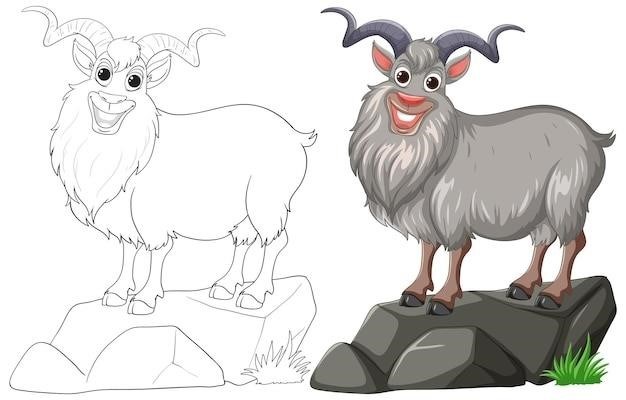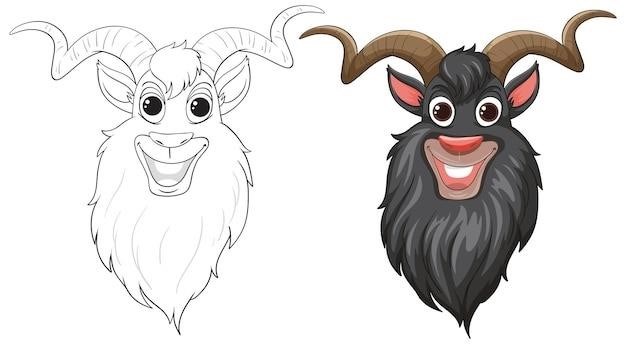Edward Albee’s “The Goat‚ or Who Is Sylvia?”
Numerous online sources indicate the availability of Edward Albee’s “The Goat‚ or Who Is Sylvia?” as a PDF․ These sources vary‚ offering full scripts‚ excerpts‚ and critical analyses․ The play‚ a Tony Award winner‚ explores themes of love‚ family‚ and societal taboos․
Synopsis and Plot Summary
Edward Albee’s “The Goat‚ or Who Is Sylvia?” centers on Martin‚ a successful architect seemingly leading an idyllic life with his wife Stevie and their teenage son Billy․ Martin’s carefully constructed world is shattered when he confesses to his best friend‚ Ross‚ a shocking secret⁚ his passionate love affair with a goat named Sylvia․ This revelation throws his family into turmoil‚ challenging their established relationships and forcing them to confront uncomfortable truths about love‚ fidelity‚ and the boundaries of acceptable behavior․ Stevie‚ initially devastated and enraged‚ grapples with betrayal and the disintegration of her marriage․ Billy‚ already navigating his own identity as a gay teenager‚ witnesses the unraveling of his family unit․ The play explores the consequences of Martin’s unconventional love and the ensuing crisis within his family‚ culminating in a dramatic confrontation that leaves the future uncertain and their lives irrevocably altered․ The narrative unfolds through tense dialogues and reveals the characters’ internal struggles with profound moral and emotional implications․

Major Characters and Their Relationships
Martin‚ a successful architect in his fifties‚ is the play’s protagonist‚ whose secret love affair forms the central conflict․ His wife‚ Stevie‚ is a strong and intelligent woman initially presented as content in her marriage‚ yet ultimately shattered by Martin’s revelation․ Their relationship‚ once seemingly stable‚ is irrevocably altered by Martin’s confession․ Their son‚ Billy‚ a gay teenager‚ observes his parents’ disintegration and grapples with his own burgeoning identity amidst the family crisis․ Ross‚ Martin’s best friend‚ acts as a confidant and sounding board‚ initially shocked by Martin’s admission but ultimately forced to confront the complexities of his friend’s actions․ The relationships in the play are characterized by a mix of love‚ betrayal‚ and unspoken resentments‚ further complicated by the unconventional nature of Martin’s affection for Sylvia‚ the goat‚ highlighting the fragility and multifaceted nature of human connections․ The characters’ interactions are pivotal to the play’s exploration of societal norms and personal morality․
Themes Explored in the Play
Edward Albee’s “The Goat‚ or Who Is Sylvia?” delves into several complex and provocative themes․ The play prominently features the exploration of unconventional love and the societal boundaries surrounding acceptable relationships․ Martin’s attraction to Sylvia challenges conventional notions of sexuality and love‚ forcing the audience to confront their own preconceived notions․ The play also examines the disintegration of family structures and the devastating consequences of secrets and betrayal․ The characters’ responses to Martin’s confession reveal the fragility of family bonds and the struggle to maintain normalcy in the face of unexpected revelations․ Furthermore‚ the play touches upon the themes of truth and self-acceptance‚ as each character grapples with their own understanding of love and morality․ The impact of societal expectations and the difficulty of defying social norms are also key elements woven throughout the narrative‚ creating a compelling exploration of human nature and its limitations․
Critical Reception and Awards
Edward Albee’s “The Goat‚ or Who Is Sylvia?” garnered significant critical acclaim upon its release and subsequent Broadway run․ The play’s controversial subject matter and unflinching exploration of taboo topics sparked heated debates and diverse interpretations among critics and audiences alike․ While some praised Albee’s masterful handling of complex themes and his ability to create compelling characters‚ others found the play’s subject matter shocking or unsettling․ Despite the polarizing nature of its content‚ the play’s theatrical merit was widely recognized‚ leading to numerous awards and nominations․ Notably‚ it won the prestigious 2002 Tony Award for Best Play‚ a testament to its impact on the theatrical landscape․ Furthermore‚ it received the 2002 Drama Desk Award for Outstanding Play‚ cementing its status as a critically acclaimed work․ The play’s success solidified Albee’s position as a leading figure in contemporary American drama‚ showcasing his talent for pushing boundaries and engaging in profound explorations of human relationships and societal norms․ Its lasting impact is evident in the ongoing discussions and interpretations surrounding its themes․
The Play’s Structure and Style
Edward Albee’s “The Goat‚ or Who Is Sylvia?” is structured in a straightforward‚ almost classical manner‚ utilizing a three-act format․ The play unfolds chronologically‚ revealing the escalating consequences of Martin’s secret relationship․ Despite this linear progression‚ Albee masterfully incorporates elements of suspense and dramatic irony to keep the audience engaged․ His signature use of sharp dialogue‚ filled with wit and barbed commentary‚ is prominent throughout․ The characters’ conversations are often laced with uncomfortable silences and underlying tensions‚ reflecting the emotional turmoil at the heart of the play․ Albee’s style is characterized by its blend of realism and heightened theatricality․ While the setting—a suburban home—is relatable‚ the events that unfold push the boundaries of conventional dramatic expectations‚ forcing the audience to confront uncomfortable truths about love‚ morality‚ and societal norms․ This juxtaposition of the familiar and the extraordinary enhances the play’s unsettling power and its enduring relevance․
Availability of the Play’s Script in PDF Format
Finding a PDF of Edward Albee’s “The Goat‚ or Who Is Sylvia?” script online requires careful searching․ While readily available in print and ebook formats‚ freely downloadable‚ complete PDF versions are less common due to copyright restrictions․ Many websites offer excerpts or critical analyses as PDFs‚ showcasing specific scenes or thematic elements․ Some academic databases may provide access to digitized versions for research purposes‚ often requiring institutional subscriptions․ Caution is advised when downloading PDFs from unofficial sources‚ as the quality and completeness of the text may vary․ Legitimate online bookstores frequently offer the play as a downloadable PDF‚ typically as a paid purchase․ These official channels ensure the accuracy and legality of the obtained script․ Remember to always respect copyright laws when accessing and distributing copyrighted material‚ ensuring ethical and legal use of the play’s script․
The Goat as a Symbol
In Edward Albee’s “The Goat‚ or Who Is Sylvia?”‚ the goat‚ Sylvia‚ transcends her literal existence‚ functioning as a potent symbol with multifaceted interpretations․ She represents the shattering of societal norms and the transgression of conventional morality‚ challenging established notions of love and acceptable relationships․ Sylvia embodies the primal‚ instinctual nature of desire‚ existing outside the constraints of human societal rules․ Her presence forces Martin‚ and the audience‚ to confront uncomfortable truths about sexuality‚ challenging the boundaries of love and acceptance․ Some interpretations suggest Sylvia symbolizes the destructive power of uncontrolled passion‚ consuming Martin and his family․ Others view her as a catalyst for self-discovery‚ forcing Martin to question his own identity and values․ The ambiguity of the symbol allows for diverse interpretations‚ making Sylvia a powerful and enduring element of the play’s enduring impact and critical discussion․
Interpretations and Analyses of the Play
Critical analyses of Albee’s “The Goat‚ or Who Is Sylvia?” frequently explore its exploration of unconventional love and its challenge to societal norms․ Many interpretations focus on the play’s ambiguous nature‚ leaving room for diverse readings of Martin’s actions and motivations․ Some see Martin’s attraction to Sylvia as a metaphor for the destructive power of unchecked desire‚ leading to the disintegration of his family․ Others view it as a commentary on the limitations of societal expectations on individual expression‚ highlighting the conflict between personal fulfillment and social conformity․ The play’s tragic elements have drawn comparisons to Greek tragedy‚ emphasizing the inevitability of fate and the consequences of defying societal boundaries․ Furthermore‚ some scholars examine the play’s use of dark humor and satire to critique societal hypocrisy surrounding sexuality and relationships․ These varied interpretations underscore the play’s complexity and its capacity to generate ongoing debate and discussion among critics and audiences alike․

Comparison to Other Works by Edward Albee
While “The Goat‚ or Who Is Sylvia?” stands as a unique work in Albee’s extensive repertoire‚ its exploration of unsettling themes and unconventional relationships echoes across his other plays․ The play shares with earlier works like “Who’s Afraid of Virginia Woolf?” a focus on the destructive potential of raw emotions and the disintegration of marital bonds under pressure․ However‚ unlike the brutal realism of “Who’s Afraid․․․”‚ “The Goat” employs a more stylized approach‚ incorporating elements of dark comedy and absurdism‚ reflecting a shift in Albee’s dramatic style․ Similar to “A Delicate Balance‚” the play probes the fragility of family structures and the complexities of human relationships‚ exploring themes of betrayal and self-deception․ Yet‚ “The Goat” delves more explicitly into taboo sexual desires‚ a subject less overtly addressed in his previous works․ The play also differs from his earlier‚ more overtly political pieces‚ focusing instead on the intensely personal struggles of its characters․ This shift in focus‚ while still maintaining Albee’s signature exploration of human vulnerability and societal constraints‚ provides a fascinating point of comparison within his broader body of work․
The Play’s Place in Contemporary Theatre
Edward Albee’s “The Goat‚ or Who Is Sylvia?” holds a significant position within contemporary theatre‚ solidifying its status as a provocative and enduring work․ Its exploration of unconventional love and challenging societal norms continues to resonate with audiences and critics alike․ The play’s success‚ marked by its 2002 Tony Award for Best Play‚ reflects its ability to engage with contemporary anxieties surrounding sexuality‚ family dynamics‚ and the boundaries of acceptable behavior․ The play’s dark humor and unsettling themes‚ while challenging‚ also contribute to its enduring appeal‚ provoking discussion and debate long after the curtain falls․ Its exploration of taboo subjects such as zoophilia serves as a catalyst for conversations around societal taboos and the complexities of human desire․ The play’s lasting impact is evidenced by its continued production and analysis in academic and theatrical circles‚ showcasing its relevance to contemporary discussions on morality‚ relationships‚ and the human condition․ Its place in the theatrical canon is secured by its provocative nature and its ability to stimulate critical engagement with complex issues․
Impact and Legacy of “The Goat‚ or Who Is Sylvia?”
The impact of Edward Albee’s “The Goat‚ or Who Is Sylvia?” extends far beyond its initial Broadway run and Tony Award win․ The play’s unflinching exploration of unconventional love and its unsettling portrayal of family disintegration continue to spark debate and critical analysis․ Its provocative themes‚ particularly the central relationship between Martin and Sylvia‚ remain a subject of scholarly discussion‚ challenging traditional notions of morality and sexuality․ The play’s enduring popularity is evident in its continued staging worldwide‚ demonstrating its continued relevance to contemporary audiences․ Furthermore‚ its inclusion in theatrical anthologies and its frequent analysis in academic circles solidify its place as a significant contribution to American drama․ The play’s lasting legacy lies in its ability to consistently provoke thought and conversation on the complex nature of love‚ relationships‚ and the challenges of maintaining family harmony in the face of societal disapproval and personal transgression․ Its impact on contemporary theatre is undeniable‚ influencing subsequent works that explore similarly challenging and unconventional themes․
Leave a Reply
You must be logged in to post a comment.